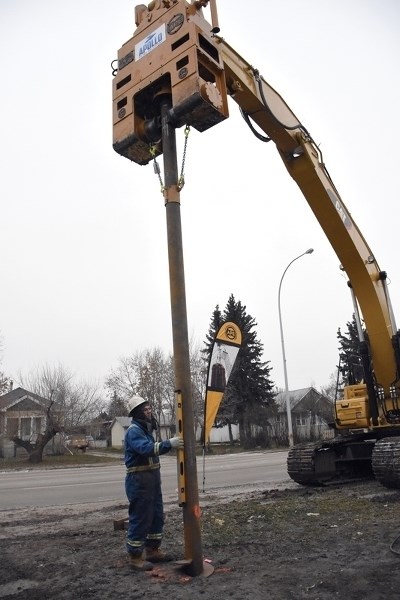The Town of Westlock is the site of an innovative geothermal technology that is trying itself out for the first time in Canada’s sub-zero climate.
The Prestige Group and A.P.E. Canada have partnered together to use helical pilings to exchange hot and cool air to heat new seniors duplexes in the community. Unlike traditional piles that require welds to fit two pieces together, the helical piles screw in like a bottle cap. A tube at both the bottom and top of the metal pile will circulate a fluid that absorbs warm air in the ground and circulates it up to heat the home. The same fluid will also exchange hot and cool air to cool the building in the summer.
Caleb West, owner of The Prestige Group, Seed Builders and Prestige Construction, and the man behind a new affordable seniors housing project in town, said the idea is the provide in-floor heating to the home and lower heating and cooling costs for residents.
West brought the idea of implementing new technology to A.P.E. Canada’s Colin Grindle about retrofitting existing homes with their helical piles.
“I expanded the conversation, which quickly grew to new homes and commercial construction, then to snowfree parking lots and sidewalks and entire subdivisions,” West said. “As we owned the project, I agreed we would use the development in Westlock as a pilot project for everything, including geo-exchange heated parking lots, sidewalks and the foundation of our triplex.”
On Nov. 18, the pile driver was on site at the corner of 99 Avenue and 100 Street. Two 20-feet piles were drilled down 80 feet as structural support. Next to the home the actual geothermal piles were installed using four piles.
Apollo Piling Solutions president Andrew Banack, whose crew installed the structure, said the installation of the screw piles was three times faster than the typical welded piles.
“It’s essentially a test on everything,” West added.
Although the technology has been used in Texas to cool buildings, this is the first time it is being used to warm a building. Think Mechanical, the renewable energy contractor, and NAIT students ran a week-long test last week to measure how fast heat can be drawn from the earth and how fast it can be reinjected back.
From that information, they can then determine what kind of system should be built and how much supplemental electricity is needed.
“To reinject heat into the earth is easy,” said Think Mechanical’s Ken McCullough. “To pull heat out of the earth here is harder because it’s not that warm down there — it’s only about five degrees. How much (energy) we can pull is the question we’re trying to answer with this.”
Typically, a geothermal system uses a plastic pipe that is drilled down 200-450 feet in the earth and the fluid that circulates within is enclosed in a pipe, he explained. In this system, the pile will only go down 80 feet and the fluid will touch the pipe. The steel pipe, he expects, will also have better conductivity.
“It will work because we know we can draw some energy out of the earth,” he said. “If we need to supplement it with electricity, than we supplement it with electricity. The idea is we’re getting free energy.”



